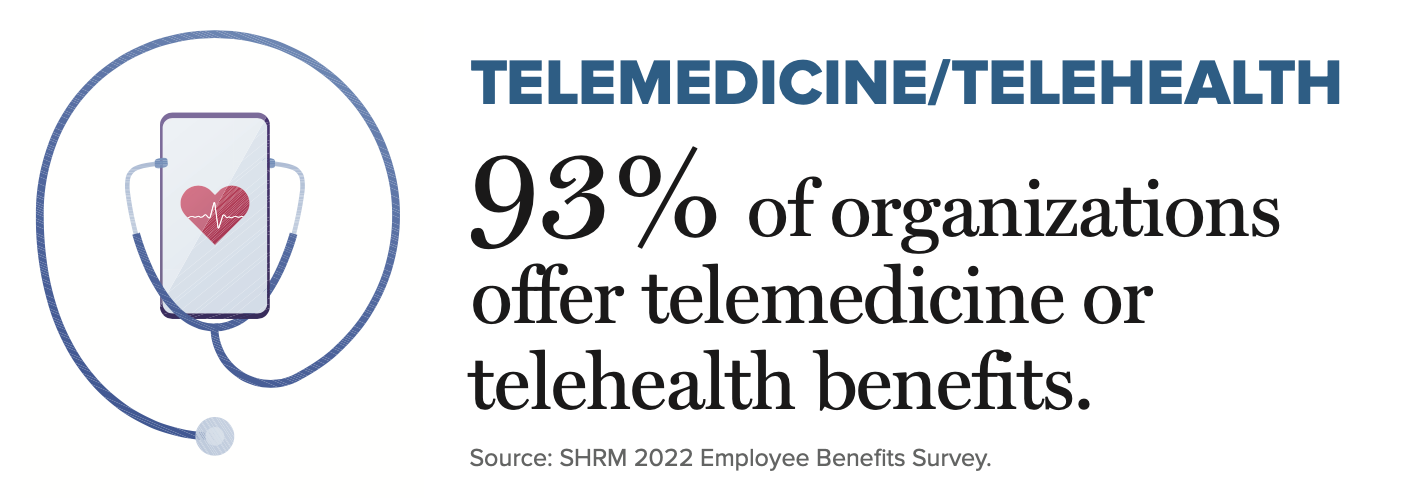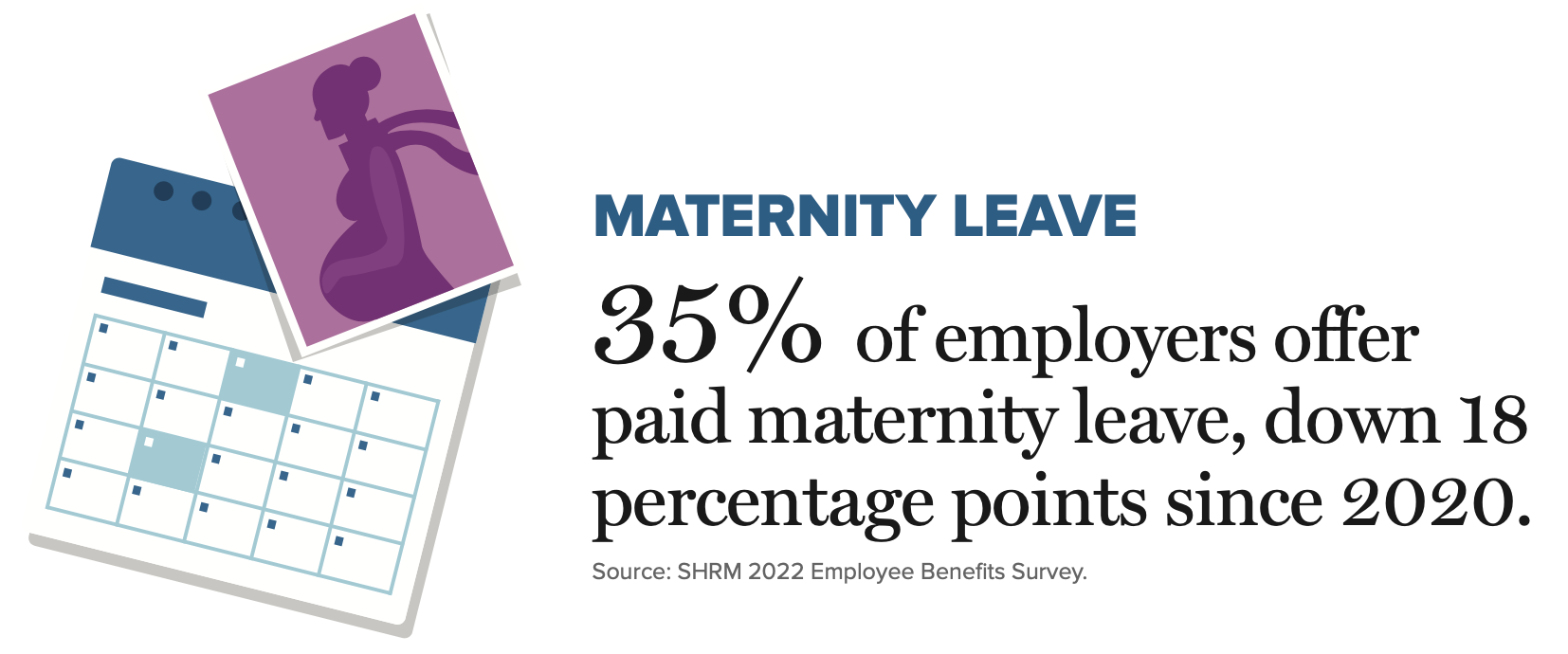
?When Tyson Miller’s stepfather passed away last year, he wasn’t handling it well. “I haven’t dealt with much death,” says Miller, an employee at Chegg, an education technology company with 1,700 employees headquartered in Santa Clara, Calif. “The HR rep connected me to counselors via Ginger.io. I used it in a time of crisis, and it was extremely helpful.”
Chegg’s mental health benefits offerings, including behavioral coaching service Ginger.io and guided meditation app Headspace, have made a difference in Miller’s life. “I’ve been leaning on those two quite a bit in times of need,” he says.
Chegg’s chief people officer, Debra Thompson, says, “We provide generous medical benefits, but we’ve also added mental health benefits, such as addiction treatment from Quit Genius.”
Many other U.S. employers are also increasing the availability of mental health benefits in response to a rising need for such services among employees. According to the Society for Human Resource Management’s (SHRM’s) 2022 Employee Benefits Survey, 91 percent of organizations offer mental health coverage, up from 85 percent in 2021.

“The pandemic forced employers to look closely at the accepted norms in benefits and compensation,” says Leslie Aument, SHRM-SCP, head of people for Kojo Technologies, a construction materials procurement platform with 95 employees in San Francisco.
While some companies seem to be catching on to what workers need, others remain out of touch and slow to respond to developing trends. According to SHRM’s 2021-2022 State of the Workplace Study, fielded late last year, 84 percent of employers are grappling with labor shortages, which begs the question: What do employees want?
Unfortunately for HR professionals, there is no easy answer. Still, workers across all demographics consistently value benefits related to three vital needs: physical health, mental health and work/life balance.
Physical Health
Benefits related to physical health top the list of what employees want, regardless of age or career stage. But employers should avoid implementing a one-size-fits-all benefits program.
“We need to provide employees with as much choice and flexibility as possible,” Thompson says. “Employees want an employer that truly cares about their holistic health—not just their medical, dental and vision. Employees appreciate benefits that meet them where they are in their life stage, [so HR should] find out what matters and figure out how to offer it.”
That means including options. “The expectation of health coverage is a given; however, individuals are looking for additional benefit choices,” says Maree Whitlow, vice president of human resources for the Dave Thomas Foundation for Adoption in Dublin, Ohio, a nonprofit with 60 employees.
“It depends on where employees are in their own lives,” adds Christina Balint, corporate HR manager at Universal Metal Products Inc., a manufacturer with 287 employees in Wickliffe, Ohio. “Someone with a family, for example, will have a greater desire for traditional PPOs [preferred provider organizations], ancillary lines of coverage like dental and vision, and possibly FSA [flexible spending account] programs. Someone working beyond retirement age may be more interested in long-term-care coverage and low-cost life insurance.”

Whitlow says the most popular benefit at the Dave Thomas Foundation for Adoption is the company-sponsored health reimbursement arrangement card. “This helps reduce out-of-pocket expenses for employees by providing them with a pre-loaded debit card, which covers 90 percent of the annual deductible of medical expenses,” she says.One notable benefit that employers increased during the pandemic and that now appears to be a permanent fixture is telemedicine. According to SHRM’s Employee Benefits Survey, 73 percent of organizations offered telemedicine in 2019, but 93 percent offer it in 2022.
“Telemedicine has entered the same sphere as sick leave in prevalence,” says SHRM researcher Derrick Scheetz. “So many people have utilized this resource, it has become an expected offering.”
To stand out from other organizations, employers may need to get creative when it comes to offering physical health benefits. For instance, in January, as a result of a request from Chegg’s women’s employee resource group, the company began offering Carrot, a fertility benefit. Says Emma McCulloch, senior director for corporate communications at Chegg, “It isn’t a broad-spectrum benefit, but for the few people who need it, it’s vitally important and life-changing.”
Mental Health
Pandemic-related measures such as videoconferencing, mask wearing, vaccine mandates and COVID-19 testing can be wearisome. Meanwhile, ongoing pandemic-related health risks have had a dramatic impact on workers’ mental health. One in 4 workers reported being highly stressed and workers under the age of 35 ranked mental health as their top concern, according to Mercer’s 2021 study of 2,000 U.S.-based employees.

T.J. Regional Health provides broad support through benefits. “Our employee assistance program [EAP] offers a wide variety of services,” says Rachel Forrester, SHRM-SCP, total rewards manager for the rural health care organization headquartered in Glasgow, Ky. Those services include financial planning, child care and education services, health and wellness seminars, and free counseling. “With the pandemic, our EAP has had a drastic rise in participation,” she says.
Another emerging trend appears to be an increase in paid time off apart from traditional sick days. About 20 percent of companies in SHRM’s Employee Benefits Survey pay employees to take days off for mental wellness. (This is the first year SHRM has asked about this benefit.) For example, the Dave Thomas Foundation for Adoption “offers three personal days, which can be used at a moment’s notice for mental health days,” Whitlow says.
Work/Life Balance
The labor shortage has left many employees with heavier burdens than in previous years, and remnants of pandemic protocols continue to cause exhaustion and confusion.
Constant stress leads to burnout. In a McKinsey & Co. study from earlier this year, 28 percent of employees said they felt burned out “sometimes, often or always” and 32 percent said they felt “moderate distress.” Respondents who experienced burnout symptoms were six times more likely to report an intent to leave their jobs in the next three to six months.
To cope with this stress, more employees seek to improve their work/life balance. They want more parental leave, ample paid time off, caregiving assistance, and flexible hours and work locations.
“Due to the pandemic, workplace flexibility has become a crucial benefit for employees, as well as generous paid time off,” Whitlow says.
Parental leave. “We’re seeing an uptick in the demand for more paid time off and paid family leave,” Balint says.
However, many companies are pulling back on paid-parental-leave policies. According to SHRM’s Employee Benefits Survey, the number of organizations offering paid maternity leave dropped from 53 percent in 2020 to 35 percent in 2022. Those offering paid paternity leave dropped from 44 percent to 27 percent over the same period.
Thus, it seems as though the increase in parental leave during the height of the pandemic may not be a permanent fixture.
Paid time off. Paid vacation time and sick leave are almost universal and have held steady as benefits offerings for years. But this year, it seems like more employees are using their vacation time now that tourist destinations have reopened. HR professionals can support this healthy behavior by reminding managers of the need to respect employees’ time away from their phones and work responsibilities.
Employers have significantly increased paid time off in one area: floating days for religious holidays that are not already federal holidays, such as Rosh Hashana and Kwanzaa. “The number of employers offering paid days off for religious holidays has been increasing steadily,” says SHRM researcher Daniel Stunes.
Child care and elder care assistance. To meet the challenges of work/life balance, employees are also seeking help with child care and elder care demands.
“Employers can retain employees by offering additional support benefits like onsite child care, backup care and elder care,” says Priya Krishnan, chief client and experience officer at Bright Horizons, a child care provider with 26,000 employees worldwide, based in Newton, Mass. “High-quality, onsite child care and backup child care benefits are at the core of what employees need to be successful.”
Remote work. Tesla CEO Elon Musk recently made headlines by requiring all employees to work from a company office a minimum of 40 hours per week. Many other employers are also demanding workers return to in-person workplaces and schedules, but employees are rebelling—and many will walk away. According to Mercer’s Inside Employees’ Minds study, 44 percent of employees want full-time remote work while only 16 percent of employers plan to continue with full-time remote work.
T.J. Regional Health is making remote work permanent for certain jobs. “Before the pandemic, we had limited opportunities to work from home. However, over the past two years, we’ve transitioned many employees to remote work,” Forrester says. Now, approximately 80 of the company’s 1,400 employees are working remotely. “We’ve received positive feedback from both managers and employees regarding productivity and job satisfaction,” Forrester says.
When job duties permit, most companies appear to have compromised with a hybrid approach that combines in-office and at-home work. SHRM’s Employee Benefits Survey found that 63 percent of employers offer a hybrid model to workers whose jobs do not require face-to-face tasks.

At the Dave Thomas Foundation for Adoption, for example, “the hybrid work environment captures the best of both worlds, allowing staff to have the flexibility they crave while continuing to build engagement and collaboration with co-workers,” Whitlow says. “Staff feel empowered to have weekly flexibility with their remote-work schedules.”
Kojo Technologies has chosen to be 100 percent remote for all employees. “We have a strong bias for asynchronous work and high trust in our remote environment,” Aument says. “This empowers our employees to work when they want to get their work done. We aren’t managing their time but [rather] their impact on our mission and their team. This flexibility is a huge benefit, and our employees truly feel they can take care of their life stuff when they need to, without having to clear their every move with their manager.”
To reinforce social ties, the entire company gathers in person at least once annually.
“Remote work is here to stay,” Scheetz says. “If you’re not embracing that as much as you can, you’re already behind in terms of looking for talent. It’s one of the premier pieces of taking care of your employees, and it has taken on a new level of importance never seen before.”
Not only that, but remote work also widens your candidate pool. “You’re going to limit your candidate pool if you can only look in the immediate geographic vicinity,” Scheetz adds.
The Aftermath
“The pandemic created a period of upheaval for employees, but it has also provided a moment of introspection, enabling them to take stock of what matters most and driving a ‘Great Realization’ to make dramatic career moves that align work with personal priorities,” Krishnan says.
For some employees, that has meant leaving their jobs. For employers, it has meant determining the areas where they were failing to meet their employees’ needs.
“What we’re hearing now is employers clearly see the connection between supporting their workforce and succeeding in the marketplace,” Krishnan says. “They’re offering employees a variety of benefits to support the diverse needs of their workforces so their employees can thrive both personally and professionally.”

Forrester sees upside in the recent upheaval. “There have been plenty of challenges throughout the Great Resignation,” she says, “but where there are challenges, there are opportunities. These opportunities allow us to be creative in what we offer to candidates and how we keep our current employees engaged.”
In the war for talent, benefits can attract a greater quantity of highly qualified applicants and prevent current employees from jumping ship. “Benefits show employees we care about them as people, and they must be diverse to meet the unique needs of every employee,” Whitlow says.
And if you’re wondering what those needs are, ask existing employees. They already know what they want.
Kathryn Tyler is a freelance writer and former HR generalist and trainer in Wixom, Mich.
Visit shrm.org/benefits to experience SHRM’s 2022 employee benefits survey interactive online tool

